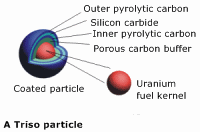Jan
16
Nuclear Fuel Competition Heats Up
January 16, 2009 | 2 Comments
South Africa’s nuclear design company Pebble Bed Modular Reactor Pty. (PBMR) has successfully manufactured coated fuel particles, which would form the basis of high temperature reactor fuel, containing only 9.6% enriched uranium. Particle fuel is a new take on fissionable fuels that will increase safety.
The fuel design is made up of low-enriched uranium, triple coated isotropic particles formed as a layer on a molded graphite sphere. A coated particle consists of a kernel of uranium dioxide, surrounded by the three coatings. Coated kernels at about one millimeter in diameter, 15,000 of these coated particles make up in a layer. The coated particles are mixed with graphite powder and a phenolic resin, then pressed into the 50 mm diameter graphite sphere. A further 5 mm of pure carbon is then added to for a non-fuel zone, and the resulting spheres are sintered and annealed to make them hard and durable. Click the photo for more details.
Made just last month, December of 2008, the fuel particles have been shipped to the Oak Ridge National Laboratory, in the U.S. From there they go to the Idaho National Laboratory for undergoing irradiation testing.
CEO Jaco Kriek noted that this achievement would give the PBMR huge credibility as a participant in the Next Generation Nuclear Plant project and supports its role of the company’s partnership in the Westinghouse-led consortium.
The new fuel is based on the design and manufacturing process employed in the last successful high-quality fuel, which was used in the German working-group research reactor, that was successfully operated for 21 years. Kriek said that the successful manufacturing of the coated particles was the culmination of several years of intense development work at PBMR’s laboratories.
Kriek says, “We have conducted extensive development work and we are satisfied that the coated particles that were produced for testing will provide proof and assurance that the PBMR will perform to its predicted best-in-the-world safety capabilities, in the process heat and electricity markets, as well as cogeneration applications.”
PBMR is a South Africa national project. The PBMR design promises to be an advanced reactor that would gain efficiency in construction through a modular design, which enables sharing of certain plant buildings and machinery. Each reactor unit would produce 165 MWe and these could be built in groups of up to eight. Cooled by helium, PBMR’s operational benefits would be a very high level of safety and the ability to produce high temperature process heat for industrial use rather than just steam driving electricity generating turbines.
For older reactors AREVA has introduced its advanced Boiling Water Reactor (BWR) fuel called Atrium 10XM in the U.S. Exelon received and accepted the first U.S. lead test assemblies for operation beginning in early 2009 in the LaSalle Unit 2 reactor. The initial group of eight assemblies is the first step toward the goal of supplying Atrium 10XM reloads for U.S. BWRs beginning as early as 2011, according to a company press release.
The Atrium 10XM fuel is the newest BWR fuel product manufactured by AREVA’s Richland Washington facility. With orders on the books from Taiwan and now the U.S. AREVA can look forward to more expansion in the Atrium product line. For an idea about what goes in to a sales pitch for reactor fuel assemblies check out this link to a pdf.
With so much interest in fission nuclear power the competition is good news. With leaner uranium density in the pebble bed method that might be part of new designs and construction increases in fission to energy looks to be on the way. Meanwhile older reactors can get more efficiency from updated fuel assembly designs that should hold the market until thorium or other entirely new reactor units are available.
The only real holdup is regulatory. AREVA is past that. PBMR and its competition are looking at a decade or longer to get to market as the schedule for the Next Generation competition is expected to run into 2021. The South African technology looks good as even the competition is using the coated particles in small hexagonal prismatic cores instead of spheres. Things are getting better, but one wonders what the U.S. DOE is doing to reduce the huge and increasing costs.
Comments
2 Comments so far




What a waste, such a toxic industry.
How about some population control instead?
Thanks for some quality points there. I am kind of new to online , so I printed this off to put in my file, any better way to go about keeping track of it then printing?